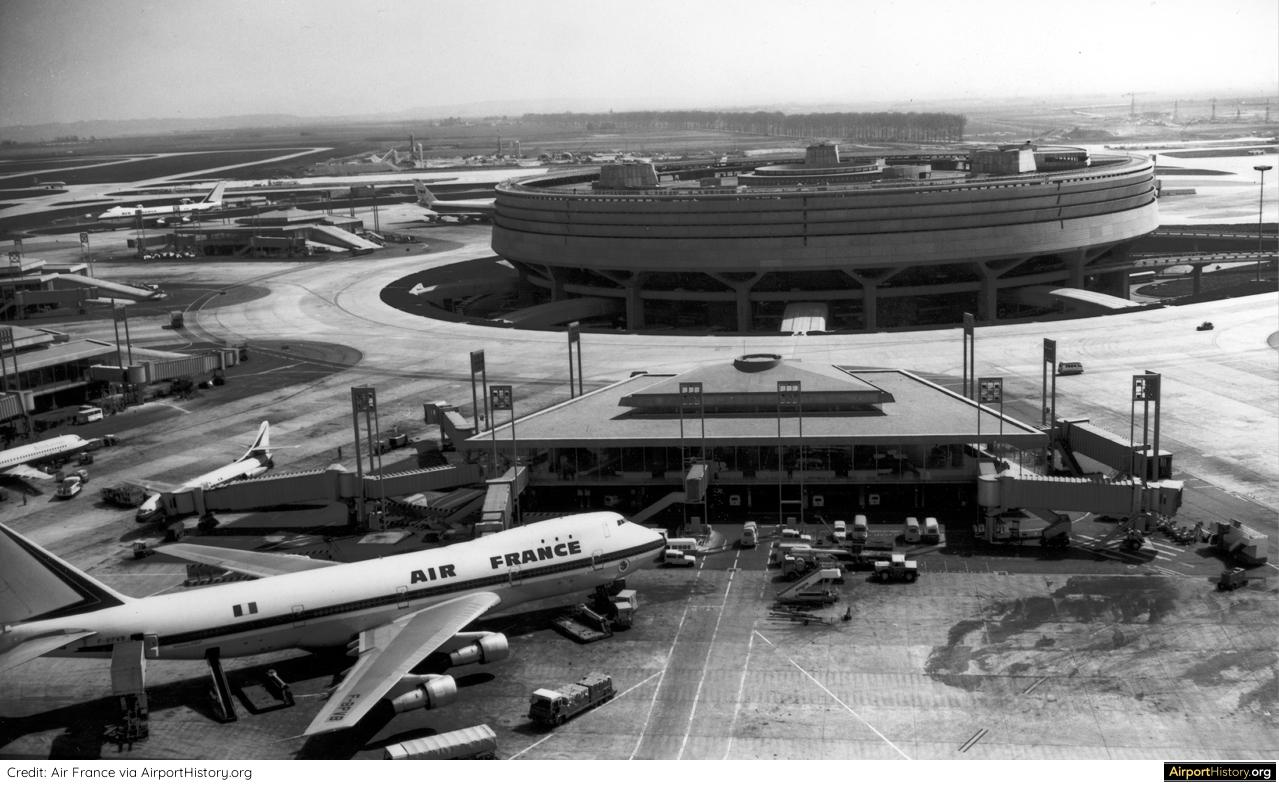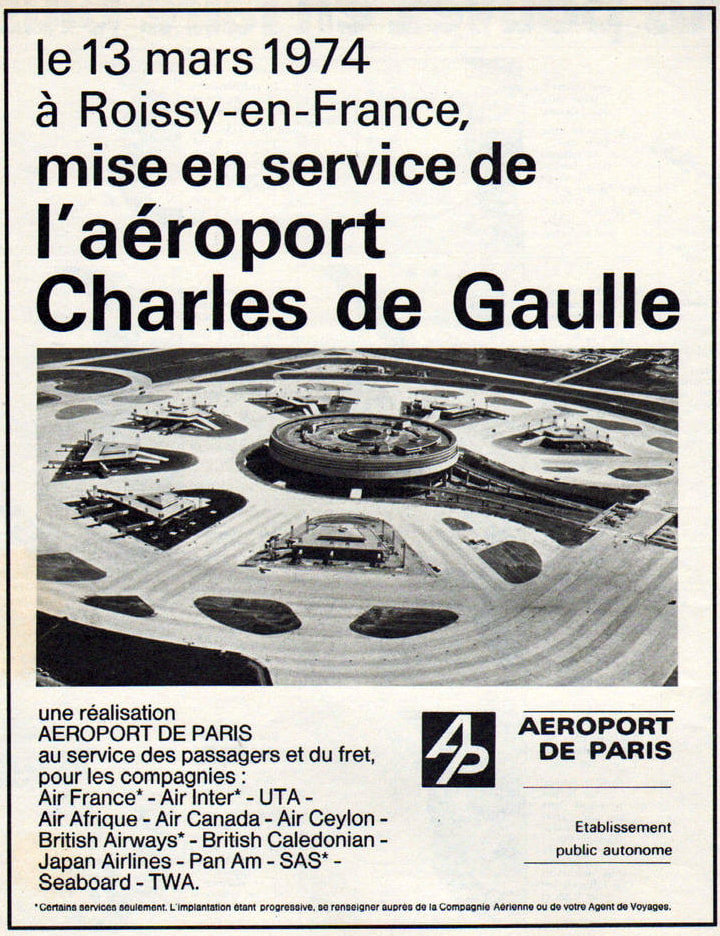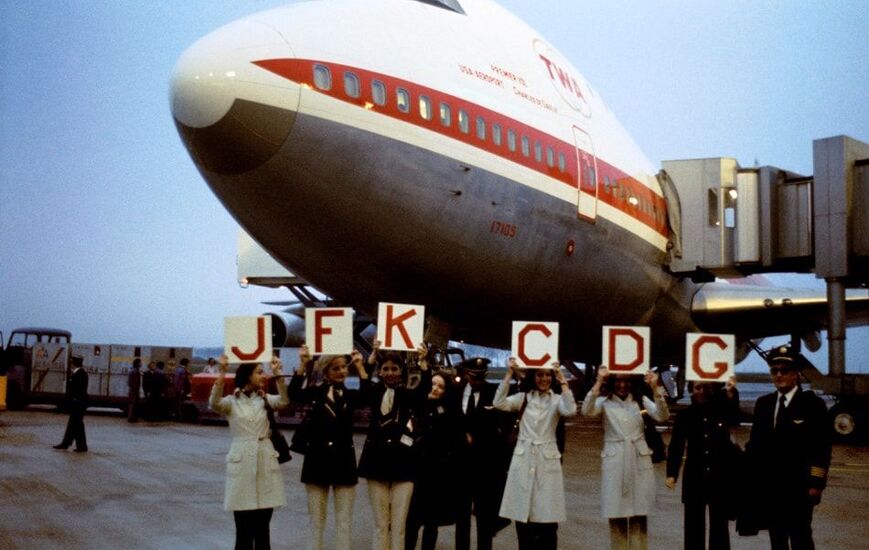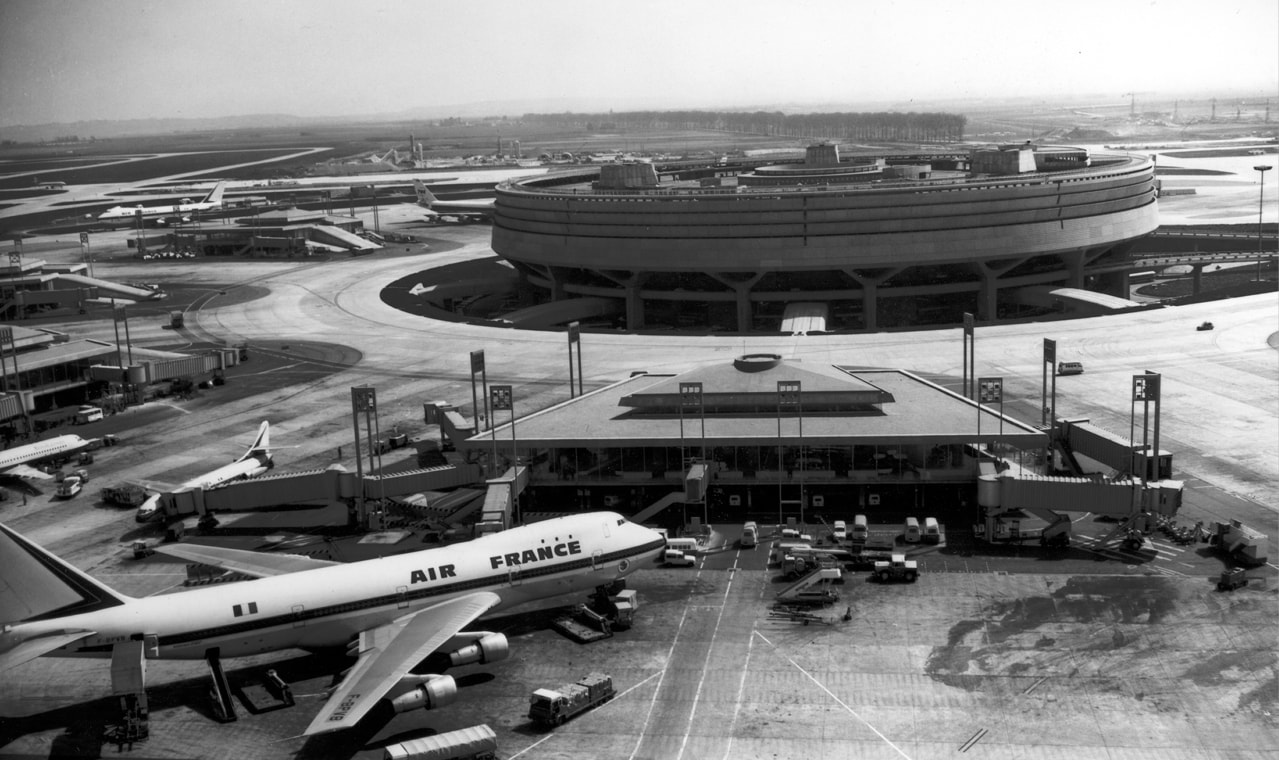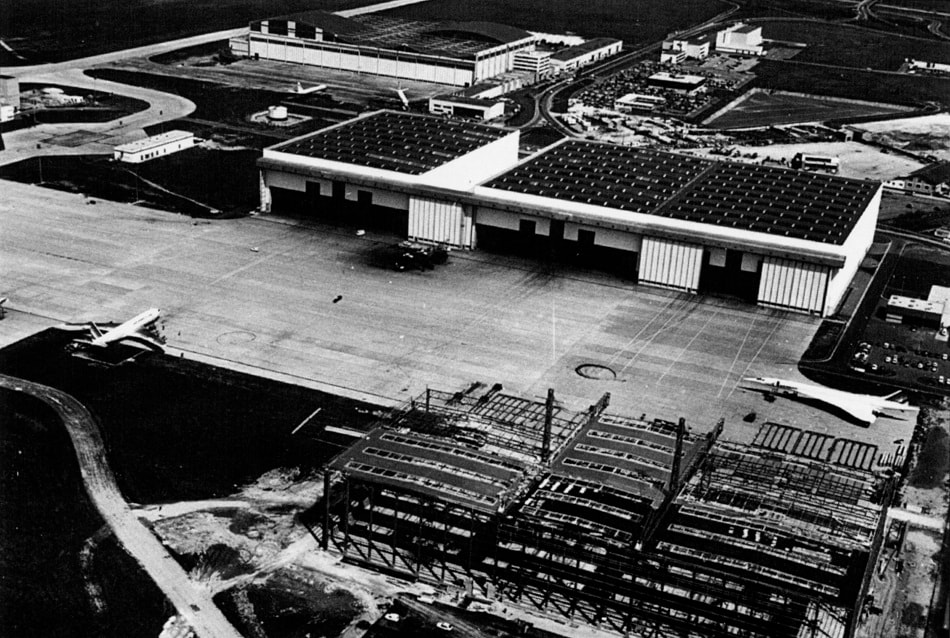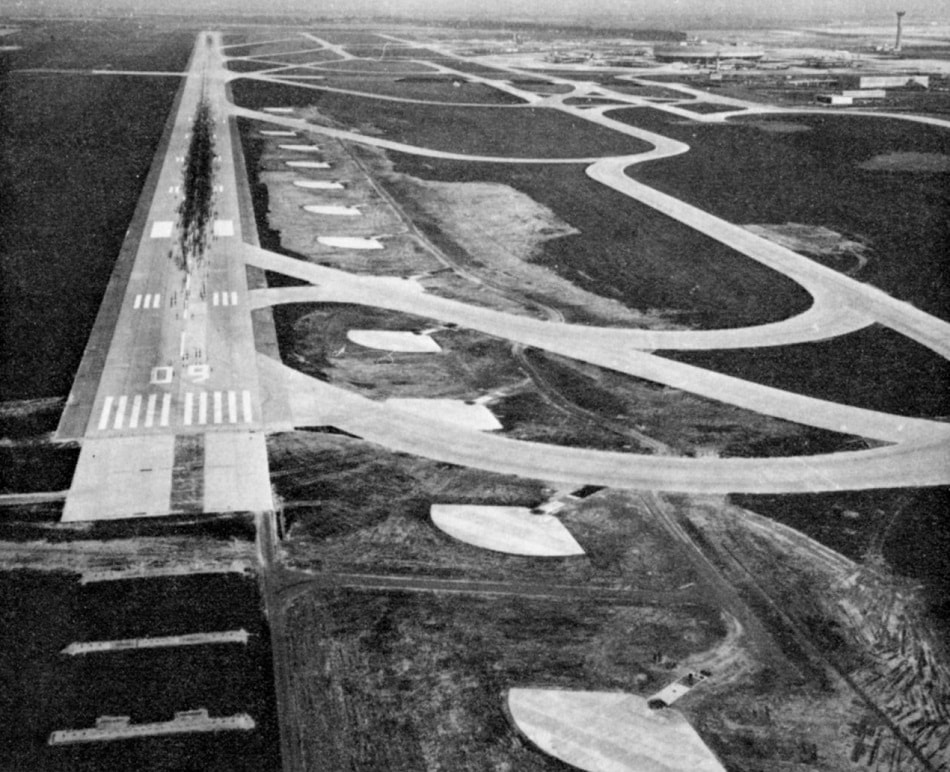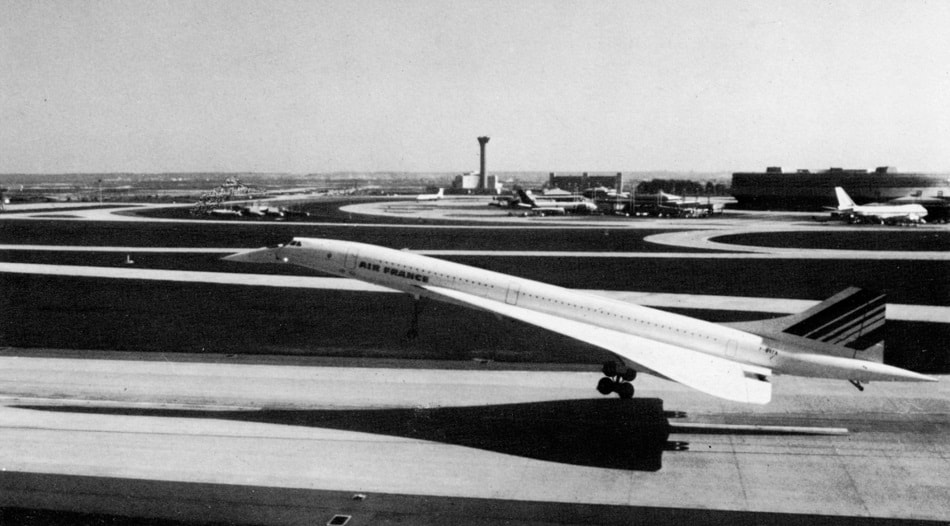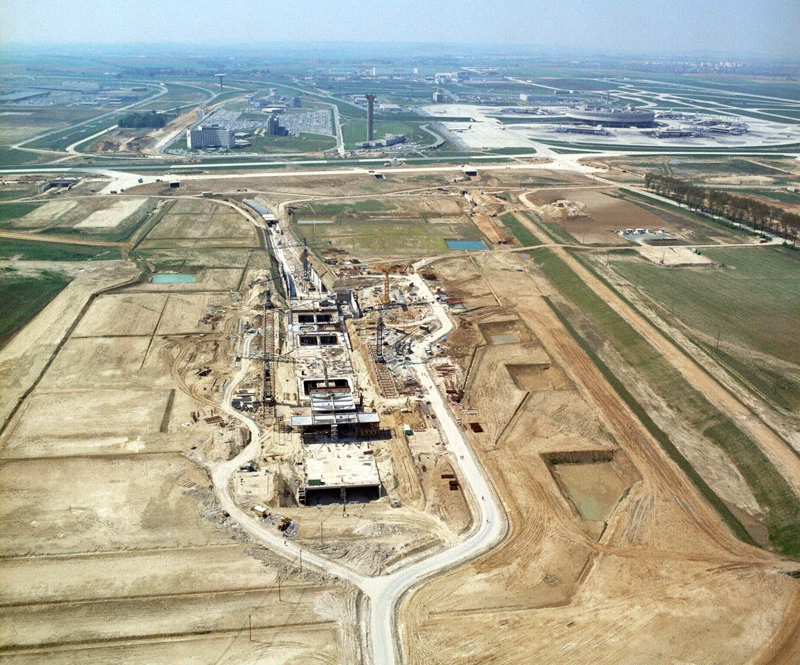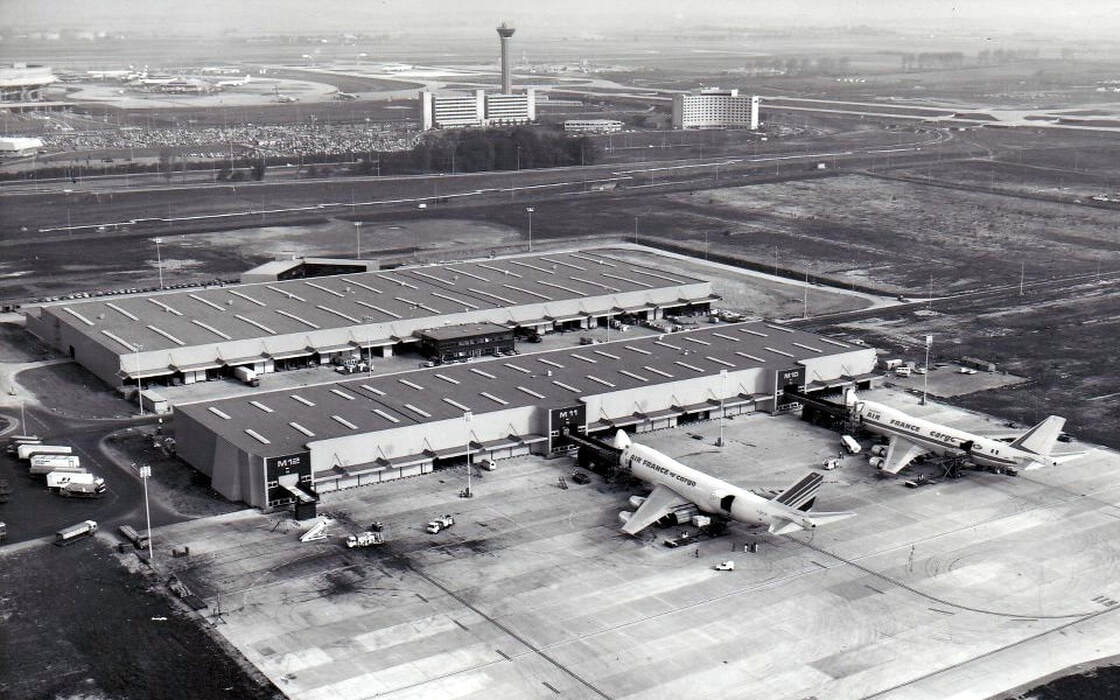Published: August 7, 2019
Introduction
Welcome to Part 2 of our history on Paris Charles de Gaulle Airport. In this Chapter, we'll show many rare and amazing images of the construction and early years of 'CDG'. We'll also learn how critics responded to the airport's spectacular and unconventional design, as well as issues that arose early on. Finally, we look at some of the early developments and milestones, such as the start of Concorde flights.
Did you miss Part 1 about the planning of Paris de Gaulle Airport? Read it here.
Did you miss Part 1 about the planning of Paris de Gaulle Airport? Read it here.
Construction
In December 1966, site preparations commenced. Construction activities started in August 1968 with the roads and the bridges over the motorway A1. Work on Aérogare 1 started the following month.
A circular hole of 820 feet (250 meters) in diameter and 65 feet (20 meters) was dug and more than 3.5 million cubic feet (a million cubic meters) of excavated material was extracted.
A circular hole of 820 feet (250 meters) in diameter and 65 feet (20 meters) was dug and more than 3.5 million cubic feet (a million cubic meters) of excavated material was extracted.
GALLERY: CONSTRUCTION
Work on the satellites started in late 1970. Also built were Air France and UTA hangars and a pooled cargo terminal. Construction on the first 11,800-foot (3,600-meter) runway, 09/27, and its associated taxiways started on August 1st, 1969.
The runway was inaugurated by the Ministry of Transport on September 9th, 1971. The earthworks of Runway 2 were started in 1972.
By September 1973, construction was finished and a few aircraft had landed -some by mistake. Originally named “Paris Nord”, and later “Roissy”, in October 1973, it was decided that the airport would be renamed after legendary French President Charles de Gaulle, who had died four year prior.
The airport was assigned the IATA code 'CDG', which would become one of the most recognizable airport codes in the world.
The runway was inaugurated by the Ministry of Transport on September 9th, 1971. The earthworks of Runway 2 were started in 1972.
By September 1973, construction was finished and a few aircraft had landed -some by mistake. Originally named “Paris Nord”, and later “Roissy”, in October 1973, it was decided that the airport would be renamed after legendary French President Charles de Gaulle, who had died four year prior.
The airport was assigned the IATA code 'CDG', which would become one of the most recognizable airport codes in the world.
Charles de Gaulle opens for business (1974)
Roissy expresses the ambition of a country that wanted, and then learned to marry its century.
- Prime Minister George Messmer
OPENING
After eight years of construction and at a cost of USD 275 million (USD 1.4 billion in 2019) the airport was opened on March 8th, 1974 by Prime Minister Pierre Messmer, during a sober one-hour ceremony with 1,000 spectators in attendance.
Five days later, at 6:51 am on March 13th, the first commercial flight, a TWA B747 from New York’s Kennedy Airport, landed at CDG with 60 passengers on board. An Air France Caravelle was the first flight to take off at 10:45 AM with a single passenger on board!
After eight years of construction and at a cost of USD 275 million (USD 1.4 billion in 2019) the airport was opened on March 8th, 1974 by Prime Minister Pierre Messmer, during a sober one-hour ceremony with 1,000 spectators in attendance.
Five days later, at 6:51 am on March 13th, the first commercial flight, a TWA B747 from New York’s Kennedy Airport, landed at CDG with 60 passengers on board. An Air France Caravelle was the first flight to take off at 10:45 AM with a single passenger on board!
The carriers that initially transferred from Le Bourget and Orly to CDG were Air Afrique, Air Canada, British Airways, British Caledonian, Japan Airlines, Pan Am, S.A.S., Seaboard World, TWA and France's second international airline UTA.
Air Inter, France's domestic airline also transferred some flights.
At first, Air France limited itself to a handful of domestic (Bordeaux, Nice, Toulouse) and European (London, Geneva, Frankfurt, Turin, Lisbon) routes but in November two-thirds of flights, were transferred to Roissy. By the end of the year C.A.A.C. (the predecessor of Air China), Saudi Arabian Airlines, and a number of African carriers had transferred their operations as well.
In its first year operation the airport handled 2.5 million passengers and 131,000 tonnes of cargo.
Air Inter, France's domestic airline also transferred some flights.
At first, Air France limited itself to a handful of domestic (Bordeaux, Nice, Toulouse) and European (London, Geneva, Frankfurt, Turin, Lisbon) routes but in November two-thirds of flights, were transferred to Roissy. By the end of the year C.A.A.C. (the predecessor of Air China), Saudi Arabian Airlines, and a number of African carriers had transferred their operations as well.
In its first year operation the airport handled 2.5 million passengers and 131,000 tonnes of cargo.
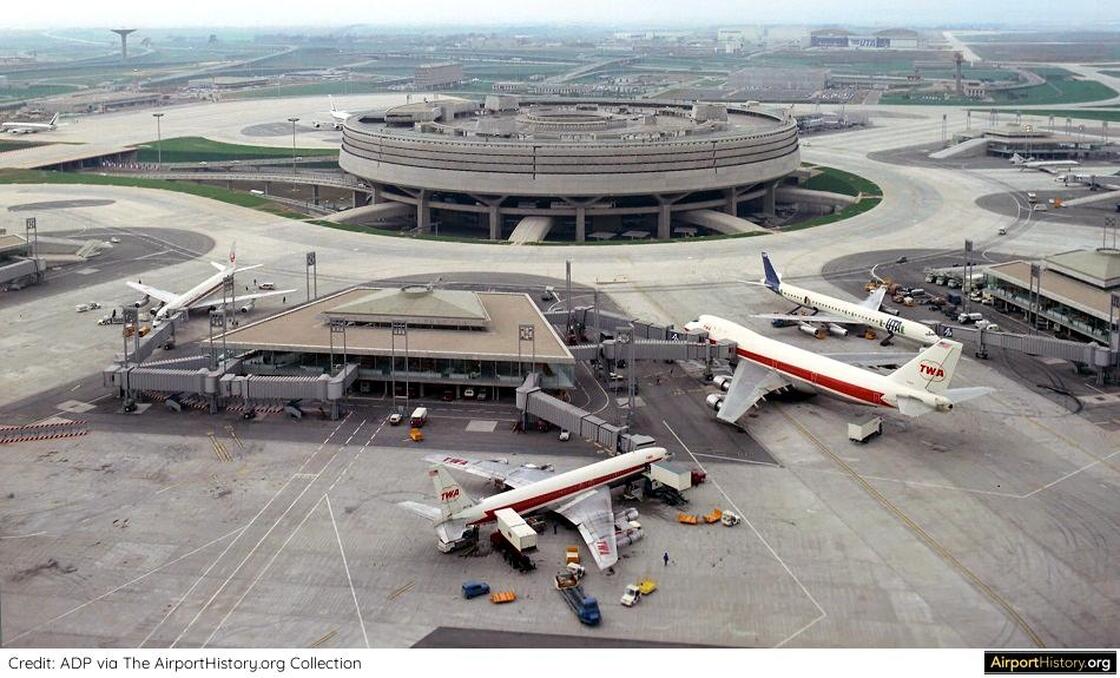
A 1976 aerial view of Aérogare 1. Each of the seven satellites was equipped with seven boarding bridges and could service five aircraft, including four Boeing-747 aircraft. TWA was one of the major foreign operators at CDG. Also visible are DC-8s belonging to Japan Airlines and UTA, which was France's second long haul airline until its absorption into Air France in 1992. Credit: ADP
IMAGE GALLERY: AERIAL AND EXTERIOR VIEWS
RECEPTION
At the time, Aérogare 1, which had quickly earned the nickname ‘le Camembert’ (a French round, soft and creamy cheese), was presented as a state-of-the-art airport for its design and operations. Aérogare 1 was described by some as strange, surrealist, fantastic, functional, practical and sober by others.
At the time, Aérogare 1, which had quickly earned the nickname ‘le Camembert’ (a French round, soft and creamy cheese), was presented as a state-of-the-art airport for its design and operations. Aérogare 1 was described by some as strange, surrealist, fantastic, functional, practical and sober by others.
Aérogare 1 was described by some as strange, surrealist, fantastic, functional, practical and sober by others.
Newspaper headlines of around the time of opening described the building as "A monument that will mark an era", "a travel machine" and even "Monster"!
The fluidity of the routes, by car, on foot, by plane, in the interweaving of curves and in the maze of halls and tunnels, lead many commentators to compare the stay in the airport to a journey:
"Have a good trip! In ten minutes, Charles de Gaulle airport will have swallowed, digested and... gently expelled you to your plane", wrote the French newspaper Le Figaro on March 7th, March 1974.
Three few days later, the same newspaper wrote: "A worrying construction, brilliant and Kafkaesque, monstrously beautiful and to which it will take getting used to in order to be worthy."
Aviation historian, Jon Proctor, who at the time was working for TWA as a flight attendant, flew into Paris de Gaulle for the first time on September 22nd, 1974. His first impression, while traveling through the glassed-in escalators, was that "it resembled Disneyland!"
However, the design's limitations and problems also became apparent, the main one being that Aérogare 1 could not be expanded. The circular layout also proved to be quite confusing to passengers, often adding to walking distances rather than shortening them.
The fluidity of the routes, by car, on foot, by plane, in the interweaving of curves and in the maze of halls and tunnels, lead many commentators to compare the stay in the airport to a journey:
"Have a good trip! In ten minutes, Charles de Gaulle airport will have swallowed, digested and... gently expelled you to your plane", wrote the French newspaper Le Figaro on March 7th, March 1974.
Three few days later, the same newspaper wrote: "A worrying construction, brilliant and Kafkaesque, monstrously beautiful and to which it will take getting used to in order to be worthy."
Aviation historian, Jon Proctor, who at the time was working for TWA as a flight attendant, flew into Paris de Gaulle for the first time on September 22nd, 1974. His first impression, while traveling through the glassed-in escalators, was that "it resembled Disneyland!"
However, the design's limitations and problems also became apparent, the main one being that Aérogare 1 could not be expanded. The circular layout also proved to be quite confusing to passengers, often adding to walking distances rather than shortening them.
VIDEO: AN AIRPORT FOR MAN (1976)
Great documentary about Charles de Gaulle Airport in its early years. In French but it's about the images! Credit: ADP
Enjoying this article?
Sign up to our e-mail newsletter to know when new content goes online!
GALLERY: AEROGARE 1 - INTERIOR IMAGES
BAGGAGE SYSTEM ISSUES
The biggest problems were presented by the semi-automated baggage system. A consequence of the design of Aérogare 1 was that the routing of the baggage was somewhat complicated.
After being checked-in baggage was taken down by lifts to the basement, where it was automatically sorted. It was then manually loaded onto containers which were taken to the satellites on trucks pulled by electric tractors that ran through tunnels.
Once they arrived at the satellites, the trucks were taken over by an operator who drove them to the aircraft. The reverse process took place on arrival. After the carts arrived on the lowest level the baggage was transferred to vertical conveyor and lifted 65 feet (20 meters) to the arrivals level, where it was fed automatically onto conventional carousels.
The whole process was quite complicated and lengthy, which resulted in long wait times for passengers who needed to collect their baggage (in a reclaim hall without seats, a bar or telephones).Adding to the problems was that one out of every hundred bags was misplaced.
The biggest problems were presented by the semi-automated baggage system. A consequence of the design of Aérogare 1 was that the routing of the baggage was somewhat complicated.
After being checked-in baggage was taken down by lifts to the basement, where it was automatically sorted. It was then manually loaded onto containers which were taken to the satellites on trucks pulled by electric tractors that ran through tunnels.
Once they arrived at the satellites, the trucks were taken over by an operator who drove them to the aircraft. The reverse process took place on arrival. After the carts arrived on the lowest level the baggage was transferred to vertical conveyor and lifted 65 feet (20 meters) to the arrivals level, where it was fed automatically onto conventional carousels.
The whole process was quite complicated and lengthy, which resulted in long wait times for passengers who needed to collect their baggage (in a reclaim hall without seats, a bar or telephones).Adding to the problems was that one out of every hundred bags was misplaced.
GALLERY: OTHER FACILITIES
Early developments
FIGHTER JET ENGINES DISPERSING FOG!
In November 1974, Charles de Gaulle and Orly airports were equipped with a fog dispersal system called 'Turboclair' (Turboclear). The system existed of a battery of 12 Mistral fighter jet engines, installed in pits at and beyond the runway threshold.
In November 1974, Charles de Gaulle and Orly airports were equipped with a fog dispersal system called 'Turboclair' (Turboclear). The system existed of a battery of 12 Mistral fighter jet engines, installed in pits at and beyond the runway threshold.
|
The system used the heat and kinetic energy of the jet engines to heat up the air above, thereby vaporizing fog droplets up to 2,600 feet (800 meters), and thus increasing visibility in the Runway 09 touchdown zone.
The system was created by Jean Bertin, who also invented the "Aerotrain" -yes, the hovertrain with a jet engine mounted on top. Mr. Bertin certainly had a fascination for finding alternative uses for jet engines! The system had one big drawback: With every landing, the engines used 400 gallons (1,500 liters) of fuel! The system was decommissioned in the 1980s. |
CONCORDE
On January 21st, 1976, Charles de Gaulle Airport and London Heathrow Airport became the first airports ever to dispatch a supersonic passenger service when Air France's Concorde F-BVFA and British Airways G-BOAA took off simultaneously, respectively bound for Rio de Janeiro via Dakar, and Bahrain.
On January 21st, 1976, Charles de Gaulle Airport and London Heathrow Airport became the first airports ever to dispatch a supersonic passenger service when Air France's Concorde F-BVFA and British Airways G-BOAA took off simultaneously, respectively bound for Rio de Janeiro via Dakar, and Bahrain.
|
In April, Air France commenced service to Caracas via Santa Maria in the Azores and in May, the carrier started service to Washington Dulles, a route which was later extended to Mexico City.
Service to New York Kennedy Airport started on November 22nd, 1977. Most of these routes were cut in 1982 due to a lack of demand, the only exception being the service to New York Kennedy Airport. |
SECOND RUNWAY
In 1976, Charles de Gaulle handled 7.5 million passengers and opened a second runway. Initially, the second runaway was built at a reduced length of 9,400 feet (2,900 meter) and without a parallel taxiway. It was only used as a backup when the main runway was inoperative or at the instruction of air traffic control. The runway could be built out to its full length of 11,800 feet (3,600 meters) and taxiways added when traffic demand required.
ROISSY RAIL
On May 30th, 1976, the airport was connected to the Paris Gare du Nord train station by a suburban RER (Réseau Express Régional) suburban light rail known as Roissy Rail. The project involved 8.32 miles (13.4) kilometers of new track and an underground four-track airport underground station.
The station, location at the 'Central Unit', had evolved from a single building housing many functions, into a conventional railway station situated at the heart of a cluster of hotels and offices.
The "Aérotrain", the high speed hovertrain that was to connect de Gaulle and Orly airports, was abandoned in July 1974, as the projected ridership would never have been able to offset the huge cost of construction. It would be another 20 years before the airport would be connected to the conventional high-speed train (TGV) network.
In 1976, Charles de Gaulle handled 7.5 million passengers and opened a second runway. Initially, the second runaway was built at a reduced length of 9,400 feet (2,900 meter) and without a parallel taxiway. It was only used as a backup when the main runway was inoperative or at the instruction of air traffic control. The runway could be built out to its full length of 11,800 feet (3,600 meters) and taxiways added when traffic demand required.
ROISSY RAIL
On May 30th, 1976, the airport was connected to the Paris Gare du Nord train station by a suburban RER (Réseau Express Régional) suburban light rail known as Roissy Rail. The project involved 8.32 miles (13.4) kilometers of new track and an underground four-track airport underground station.
The station, location at the 'Central Unit', had evolved from a single building housing many functions, into a conventional railway station situated at the heart of a cluster of hotels and offices.
The "Aérotrain", the high speed hovertrain that was to connect de Gaulle and Orly airports, was abandoned in July 1974, as the projected ridership would never have been able to offset the huge cost of construction. It would be another 20 years before the airport would be connected to the conventional high-speed train (TGV) network.
GALLERY: ROISSY RAIL STATION
CARGO EXPANSION
CDG was rapidly developing into an important cargo hub. In 1977, the airport handled 247,000 tonnes of cargo, almost twice as much as Orly, which in terms of passenger traffic was still the busiest of the two. During 1977, Air France opened its own cargo terminal in two phases.
First to come into use was the dock building, which was used for large shipments. The state-of-the art facility provided three contact stands for B747 freighters, which could be directly loaded through the nose. Second phase was a warehouse located adjacent to the dock building. The entire unit covered 81.5 acres (33 hectares) and could be greatly enlarged.
CDG was rapidly developing into an important cargo hub. In 1977, the airport handled 247,000 tonnes of cargo, almost twice as much as Orly, which in terms of passenger traffic was still the busiest of the two. During 1977, Air France opened its own cargo terminal in two phases.
First to come into use was the dock building, which was used for large shipments. The state-of-the art facility provided three contact stands for B747 freighters, which could be directly loaded through the nose. Second phase was a warehouse located adjacent to the dock building. The entire unit covered 81.5 acres (33 hectares) and could be greatly enlarged.
To be continued in Part 3!
This concludes Part 2 on our history on Paris Charles de Gaulle Airport. Part 3 - to be uploaded soon - we will see how the planners had to rethink their approach for the second generation of terminals.
Did you miss Part 1 about the planning and design of Paris the Gaulle Airport? Read it here.
Did you visit CDG in the early years? Tell us about it below!
Did you miss Part 1 about the planning and design of Paris the Gaulle Airport? Read it here.
Did you visit CDG in the early years? Tell us about it below!

